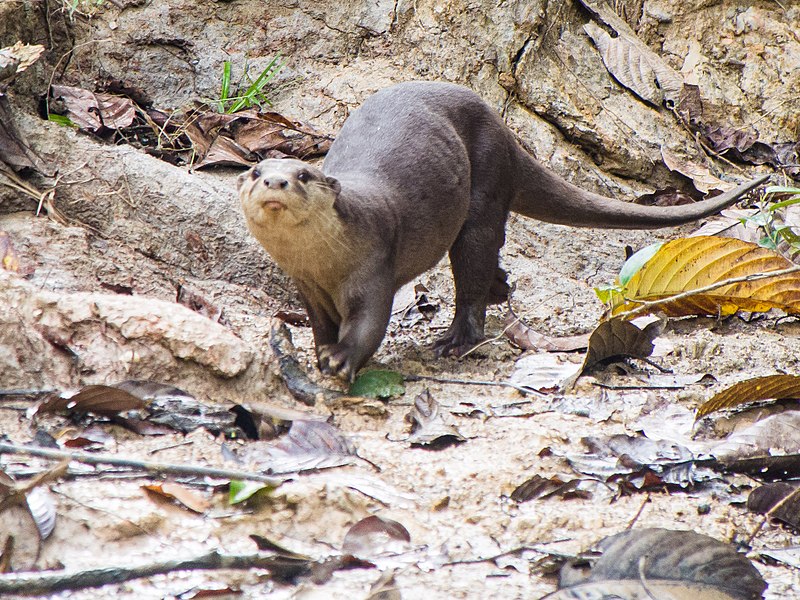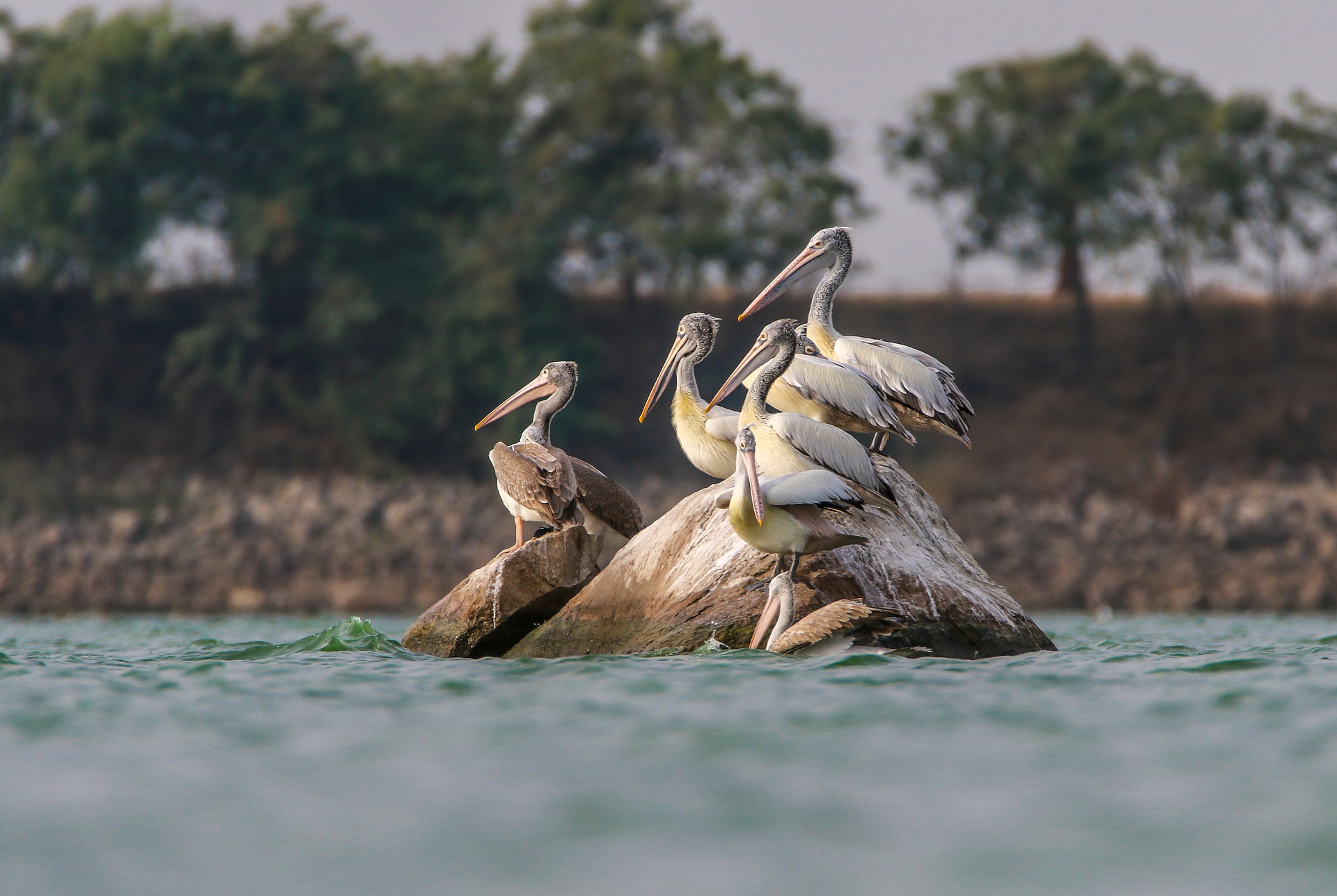
Sight of endangered otter excites conservationists, but threatens birds
The unexpected sighting of an otter in the lake waters of the Uppalapadu Bird Sanctuary, on the outskirts of Guntur in Andhra Pradesh recently, has generated excitement among birders, conservationists and the public. The smooth-coated otter, locally called Neeti Kukka or water dog, made its appearance at the end of January this year, at the sanctuary important for the near-threatened spot-billed pelicans (Pelecanus philippensis). “We have reports that there are about 15 of the otters in the wetland of the sanctuary that spreads across eight to nine acres now,” said Divisional Forest Officer (DFO), G. Siva Prasad.

The unexpected sighting of an otter in the lake waters of the Uppalapadu Bird Sanctuary, on the outskirts of Guntur in Andhra Pradesh recently, has generated excitement among birders, conservationists and the public. The smooth-coated otter, locally called Neeti Kukka or water dog, made its appearance at the end of January this year, at the sanctuary important for the near-threatened spot-billed pelicans (Pelecanus philippensis). “We have reports that there are about 15 of the otters in the wetland of the sanctuary that spreads across eight to nine acres now,” said Divisional Forest Officer (DFO), G. Siva Prasad.
The Uppalapadu bird sanctuary attracts over 15,000 birds, including large numbers of the three popular ones— the open-billed stork, spot-billed pelicans and painted stork. There are also spot-billed ducks, darters, black-headed ibis and other migratory birds in significant numbers. There are hardly any records of sighting of otters in the area.
The smooth-coated otter is listed as ‘vulnerable’ in the IUCN Red List of Threatened Species. While the presence of the otter is good news, said ecologists, there is a question over whether otters will be a threat to the birds or disturb the bird haven in any way. A recent incident of an otter attacking a bird has raised these doubts. Normally seen in groups, smooth-coated otters feed on fish, reptiles, amphibians and other marine life.
India is home to three species of otters: the small-clawed otter (Aonyx cinereus), the smooth-coated otter (Lutrogale perspicillata) and Eurasian otters (Lutra lutra). All three species of otters are protected in India under the Wildlife (Protection) Act, 1972 (WPA). Karnataka has the country’s first otter reserve acknowledging the importance of this species of wildlife and taking necessary action to protect them before it is too late. The Tungabhadra Otter Reserve Sanctuary, a 34-km stretch of habitat along the Tungabhadra river from Mudlapura village to Kampli in Ballari district, was notified in 2016.
India is a hotspot of otter poaching, according to a 2016 report by TRAFFIC, the wildlife trade monitoring network. Of the 167 otter seizures in South and Southeast Asia between 1980 and 2015 — consisting of around 6,000 otters — 53 percent seizures involved India, the TRAFFIC team found. This intense otter trade mainly caters to China’s demand for otter skin and fur and persists despite India’s native otter species being protected by national law.
Andhra Pradesh is endowed with quite a few sanctuaries and wetlands. Among them are Kolleru Lake, Pulicat lake, Nelapattu and Uppalapadu. While Kolleru is one of the largest freshwater lakes in India with an area of approx 245 sq km and identified by the Ramsar Convention for protection and conservation of wetlands, Uppalapadu is the smallest. In most of these sites, however, human encroachments and ecological problems have been impacting bird and marine life over the last few decades. Kolleru Lake has shrunk by a third as aquaculture boomed in the East and West Godavari districts, where it is located. Similarly, Pulicat in Nellore district, which is the largest lagoon with rich birdlife, especially flamingos, is suffering too.
The Uppalapadu sanctuary story
For a bird watcher or even a curious tourist, the Uppalapadu bird sanctuary is just a 15-minute drive from Guntur. An early morning visit between September and December (the breeding period) can be a feast to the eyes. Thousands of birds on the nesting perches, the trees and the lake are common. The occasional swoop by a bird to snap up a fish or the flight of some can turn into a memorable trip here.
The State Forest Department has created facilities for tourists to enjoy the sights, stay and is putting in efforts to conserve it. There are Eco-Development Committees constituted with experts by the Department to guide the efforts, said DFO Siva Prasad.
However, the sanctuary in its present size is too small to support the dense bird population. There is a need to expand it by at least five times. In addition, efforts should be made to improve the biological ecosystem and conservation practices, said Mruthyunjaya Rao, who along with the villagers is credited with reviving the Sanctuary and attracting the pelicans back to nesting during 1998-2010. The 77-year-old, self-taught conservationist, began his efforts sometime in 1989 with regular monitoring of birdlife. The village communities pitched in by helping revive the large water body, improving greenery and more and in 1992, a group of painted storks started visiting the lake. Their painstaking efforts yielded results a decade later when the first pelican was sighted in 1998, recalls, Rao.
According to a study by Salim Ali Centre for Ornithology and Natural History, there was an increase in the breeding population (400 individuals in October 2007 to 1,500 in February 2008) of this bird in Uppalapadu Lake compared to other areas of India, where there was a drastic decline due to human disturbances near nesting sites, poaching, and lacking the pelican’s primary food source: fish.
Even the Nelapattu Bird Sanctuary, spread over 450 hectares in Nellore district, a popular breeding spot for the spot-billed pelican, failed to attract good numbers during the 1990s. “The credit for getting the birds back to Uppalapadu should go primarily to the village residents who came forward to protect the water body and helped me and some dedicated forest officials over a decade,” recalled Mrutyunjaya Rao, who lives in Kakinada, about 250 from the sanctuary now. It took nearly 15 years of sustained efforts from the village residents and his small group to develop the habitat, trees, nesting areas, etc. and turn the place into a sanctuary with a sizeable bird population and get public attention, he said.
Uppalapadu is now an ecologically well-settled habitat for the pelicans, painted storks and the open-billed stork. The islanded area has a good habitat, nesting spaces on trees and provides secure space for birds said K. Thulsi Rao, a former member of the Andhra Pradesh Biodiversity Board.
Also read: Kerala bird atlas, a first in Asia, goes a long way in conservation
The flourishing number of the bird population in a way holds up the sanctuary like a thermometer reflecting the good ecological health of the area and biological mix of food and nesting for the species. But, the challenge is to sustain it.

As the spread of the water body is too small to house the increasing bird population, there is an urgent need to create more nesting facilities both artificial in the short term and growing trees in the long run. Further, the farmers around should be dissuaded from using or overusing artificial fertilisers and chemicals, whose residues are flowing into the lake and posing a threat to the fishes and insects and thereby to the birds, he observed.
In addition, human encroachments too are posing a problem here. There are policies to halt all these and improve conservation, but need to be implemented with the support of the local people, said Rao. A forest service officer, Rao has worked with the United Nations Development Programme (UNDP) on a coastal marine biodiversity project as well as 18 years in Nallamalla forests, especially tiger reserve areas, saving the great Indian bustard as part of his tenure with the State Forest Department.
Also read: Paradise reclaimed: How ordinary citizens are helping conserve birds
The otter and pelican challenges
Since the density of birds is far higher in relation to the space available at present, there is an urgent need to carry out observation and study of the challenge posed, if any, by the presence of otters. The eco-development committee, forest officials and some local enthusiasts should coordinate and do it said, Mrutyunjaya Rao. According to him, there have been reports of otters surfacing in the lake waters for several months.
Lamenting that there was more emphasis on the promotion of tourism than ecological development, he feels the government should acquire more farmland around the lake and improve the habitat and nesting places. The other urgent issues to be addressed to protect and conserve the sanctuary are that the government should solve the long-pending drinking water problems of the neighbourhood farmers who play a key role and do more awareness and conservation programmes, said Rao.
(This article first appeared on Mongabay)

